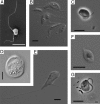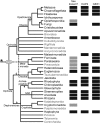Sex is a ubiquitous, ancient, and inherent attribute of eukaryotic life
- PMID: 26195746
- PMCID: PMC4517231
- DOI: 10.1073/pnas.1501725112
Sex is a ubiquitous, ancient, and inherent attribute of eukaryotic life
Abstract
Sexual reproduction and clonality in eukaryotes are mostly seen as exclusive, the latter being rather exceptional. This view might be biased by focusing almost exclusively on metazoans. We analyze and discuss reproduction in the context of extant eukaryotic diversity, paying special attention to protists. We present results of phylogenetically extended searches for homologs of two proteins functioning in cell and nuclear fusion, respectively (HAP2 and GEX1), providing indirect evidence for these processes in several eukaryotic lineages where sex has not been observed yet. We argue that (i) the debate on the relative significance of sex and clonality in eukaryotes is confounded by not appropriately distinguishing multicellular and unicellular organisms; (ii) eukaryotic sex is extremely widespread and already present in the last eukaryotic common ancestor; and (iii) the general mode of existence of eukaryotes is best described by clonally propagating cell lines with episodic sex triggered by external or internal clues. However, important questions concern the relative longevity of true clonal species (i.e., species not able to return to sexual procreation anymore). Long-lived clonal species seem strikingly rare. We analyze their properties in the light of meiotic sex development from existing prokaryotic repair mechanisms. Based on these considerations, we speculate that eukaryotic sex likely developed as a cellular survival strategy, possibly in the context of internal reactive oxygen species stress generated by a (proto) mitochondrion. Thus, in the context of the symbiogenic model of eukaryotic origin, sex might directly result from the very evolutionary mode by which eukaryotic cells arose.
Keywords: eukaryotes; evolution; protists; reactive oxygen species; sex.
Conflict of interest statement
The authors declare no conflict of interest.
Figures



References
Publication types
MeSH terms
Substances
Associated data
- Actions
- Actions
- Actions
- Actions
LinkOut - more resources
Full Text Sources
Other Literature Sources

